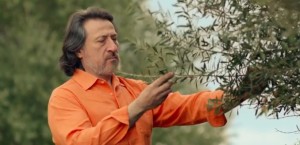There are some films that you watch and repeatedly think to yourself, “Wow, that’s beautiful.” The director, cinematographer and often-overlooked location scout mesh their talents to harvest the world around them through the camera’s lens. Leaves of the Tree, the debut feature film by director Ante Novakovic, is one of these films. It drinks in its Sicilian setting like a golden wine. There’s a fine film in this film, too, but its aesthetics steal the show. I had flashbacks of the liquid sunlight pouring over the ancient Greek temple where the action begins, and the haunting central concept of an ancient olive tree with purportedly miraculous healing properties that has grown out of an early Christian chapel, perhaps grafted directly from the tree whose wood produced the True Cross.
Novakovic is not yet a household name, but is known and respected within the film industry. His, was an unusual route to directing his own feature, having worked alongside and in conjunction with Harvey Keitel then Colin Farrell for over a 23 year period in their respective production companies. He has worked on over 60 feature films allowing him a unique perspective into filmmaking. As an executive assistant, he was privy to how films were made behind-the-scenes. Novakovic became proficient in the dynamics of each departments unique contribution and how a film came together – almost a producer in miniature. He and Stanley Kubrick spent hours on the set of Eyes Wide Shut chatting about growing up in the Bronx, and he has traveled extensively while on location soaking up the art and craft of filmmaking. He directed several short films, including one that took home a Best Short award at the Gasparilla International Film Festival. This is his first feature.
 The plot follows a successful patent attorney, played by Eric Roberts, who is suffering from heart problems and is being pushed toward retirement by his firm. He takes on one last project, helping to research and patent the leaves of a specific olive tree in Sicily that seems to have almost magical healing powers to regenerate tissue – and maybe more. He sets off with a representative from the pharmaceutical giant which hopes to profit from the leaves (Marisa Brown) and they settle in at the villa of a doctor who is a local healer (Federico Castelluccio), using the tree to tend to the ill in his community. There are elements of a darker, more elaborate plot (a sinister priest wants to co-opt the miraculous tree to raise his status within the Vatican), but this is largely a drama about faith and healing, with the Sicilian landscape as the star, followed by the underrated Eric Roberts, who throws himself into his part with joy and charisma – he positively bubbles when on-screen, and as a viewer I couldn’t wait for him to return. There is star power and there are fine actors, and Roberts has the capabilities and innate ebullience of a proper star.
The plot follows a successful patent attorney, played by Eric Roberts, who is suffering from heart problems and is being pushed toward retirement by his firm. He takes on one last project, helping to research and patent the leaves of a specific olive tree in Sicily that seems to have almost magical healing powers to regenerate tissue – and maybe more. He sets off with a representative from the pharmaceutical giant which hopes to profit from the leaves (Marisa Brown) and they settle in at the villa of a doctor who is a local healer (Federico Castelluccio), using the tree to tend to the ill in his community. There are elements of a darker, more elaborate plot (a sinister priest wants to co-opt the miraculous tree to raise his status within the Vatican), but this is largely a drama about faith and healing, with the Sicilian landscape as the star, followed by the underrated Eric Roberts, who throws himself into his part with joy and charisma – he positively bubbles when on-screen, and as a viewer I couldn’t wait for him to return. There is star power and there are fine actors, and Roberts has the capabilities and innate ebullience of a proper star.
Living in Europe as I do, and seeing a lot of independent European films, I have a good radar for European versus American films. We might even call them films versus movies. The American style expects little of the audience, and often thinks relatively little of them, expecting them to require lots of quick-cut editing, lots of action and peril, explications and exegeses of every detail of a story (“explaining away” anything that might endure with a question mark) – as if there is the fear that an audience left without action for more than a few minutes is in danger of walking out of the theater, or falling asleep, and that viewers will be annoyed if they are not spoon-fed a clear summary of what is happening before the film’s end. When I see a film that does not adhere strictly to these characteristics, I consider it more European in its overall feel (even if the film is made by an American). Such is the case with Leaves of the Tree.
There is one shot in the film that makes this distinction for me. After a long and wine-filled dinner on their first night in Sicily, the American visitors down their first limoncello and begin to dance. The dance sequence goes on for about a minute, allowing the audience into the scene itself. My American roots poked through my European-based professor flooring and made me think, about 20 seconds in, possibly some of my fellow countrymen would begin wondering why we needed more of this dance sequence, lovely though it is. An American “movie” wouldn’t necessarily make an allowance for the audience to experience such a cultural event, expression of custom, identity of region. A European lilt in “film” allows for a more encompassing visual identity such as a culturally relevant dance sequence like those offered in such films as The Deer Hunter and The Godfather (as well as the wedding procession in Sicily). One perspective is not better than the other, evolving into two very different theories on film, moreover theories as to what audiences come to expect from a film. The two afore-mentioned films were both made by American filmmakers and like Leaves of the Tree they signify a more European framework in their overall identity.
 As I write, Leaves of the Tree has yet to confirm its US distribution. It should soon enough, as it’s more than reason enough just to see its gorgeous cinematography on a big screen. The languorous, thoughtful, soulful experience on the part of the audience would be more appreciated if viewed in that context. On the European festival circuit, cinematography is praised, pace is accepted as artful, room for the audience to breath is taken as an opportunity for the imagination to thrive. This film has the gloss and aesthetic of a big budget feature from anywhere the world over, but its soul is European. Ante Novakovic is a New Yorker born to Croatian parents, spending a good deal of time in and around the Adriatic. Something has clearly rubbed off, and his Sicilian film will likely meet its greatest success with audiences looking to be lulled into an otherworldly landscape, colored by the inherent mysticism and spirituality at play.
As I write, Leaves of the Tree has yet to confirm its US distribution. It should soon enough, as it’s more than reason enough just to see its gorgeous cinematography on a big screen. The languorous, thoughtful, soulful experience on the part of the audience would be more appreciated if viewed in that context. On the European festival circuit, cinematography is praised, pace is accepted as artful, room for the audience to breath is taken as an opportunity for the imagination to thrive. This film has the gloss and aesthetic of a big budget feature from anywhere the world over, but its soul is European. Ante Novakovic is a New Yorker born to Croatian parents, spending a good deal of time in and around the Adriatic. Something has clearly rubbed off, and his Sicilian film will likely meet its greatest success with audiences looking to be lulled into an otherworldly landscape, colored by the inherent mysticism and spirituality at play.
Noah Charney is best-selling author of The Art of Forgery and writes regularly for Film International. Join him at www.noahcharney.com or on Facebook.

